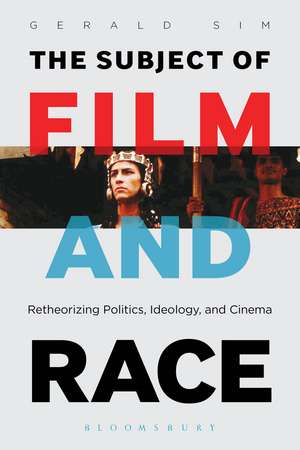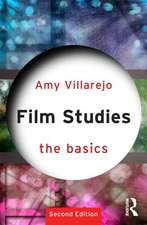The Subject of Film and Race: Retheorizing Politics, Ideology, and Cinema
Autor PhD Gerald Simen Limba Engleză Paperback – 24 sep 2014
| Toate formatele și edițiile | Preț | Express |
|---|---|---|
| Paperback (1) | 191.85 lei 6-8 săpt. | |
| Bloomsbury Publishing – 24 sep 2014 | 191.85 lei 6-8 săpt. | |
| Hardback (1) | 831.83 lei 6-8 săpt. | |
| Bloomsbury Publishing – 24 sep 2014 | 831.83 lei 6-8 săpt. |
Preț: 191.85 lei
Preț vechi: 222.87 lei
-14% Nou
Puncte Express: 288
Preț estimativ în valută:
36.71€ • 38.33$ • 30.31£
36.71€ • 38.33$ • 30.31£
Carte tipărită la comandă
Livrare economică 15-29 aprilie
Preluare comenzi: 021 569.72.76
Specificații
ISBN-13: 9781623567538
ISBN-10: 162356753X
Pagini: 240
Ilustrații: 30 bw illus
Dimensiuni: 152 x 229 x 20 mm
Greutate: 0.36 kg
Editura: Bloomsbury Publishing
Colecția Bloomsbury Academic
Locul publicării:New York, United States
ISBN-10: 162356753X
Pagini: 240
Ilustrații: 30 bw illus
Dimensiuni: 152 x 229 x 20 mm
Greutate: 0.36 kg
Editura: Bloomsbury Publishing
Colecția Bloomsbury Academic
Locul publicării:New York, United States
Caracteristici
Illustrates concepts with analyses of classical, contemporary, commercial, and independent films, such as The Searchers
Notă biografică
Gerald Sim is Associate Professor of Film Studies at Florida Atlantic University, USA. His writing on topics ranging from national cinema to digital cinematography, financial television, and film music theory appears in Film Quarterly, Inter-Asia Cultural Studies, Projections, Rethinking Marxism, the Quarterly Review of Film and Video, Discourse, and other venues.
Cuprins
List of IllustrationsAcknowledgementsIntroduction: What is Critical Race Film Studies?Chapter 1: Key Developments in Critical Race Film StudiesFirst Generation CriticismSecond Generation CriticismSeparate and Equal: The Impact of Identity PoliticsChapter 2: Theorizing Race with a Wide Open Text: The SearchersSearching for Closure, Ford, and EthanChapter 3: Poststructuralism and the Neo-Marxian SubjectCritical Subjects, Cinema, and the Culture IndustryThe Subject of Adorno's ContradictionsRacial Subjects and the Problem of Biological EssentialismChapter 4: Postcolonial Hazards: Edward Said and Film StudiesFilm Studies' Poststructuralist Readings of OrientalismWhat is a Saidian Methodology for Race in Film Studies?Chapter 5: Postmodern Multiracial, Keanu ReevesHybridity, Postmodern Subjectivity, and Keanu ReevesMultiracials and Postmodern AhistoricismHybrid Politics in Film StudiesCyborg MetaphorsConclusionA Materialist Method for Critical Race Film StudiesBibliography
Recenzii
The Subject of Film and Race is a skillful foray into deeper issues of critical theory in the realm of films. Sims analysis establishes a clear foreground for the materialist approach to film studies that he outlines at the conclusion of the book . With the boundaries of identity blurred, Sim's approach allows critics to be concerned with core issues, neither burdened by essentialism, nor ambiguous or shifting subjectivities.
At once erudite and eminently readable, The Subject of Film and Race proposes a bold new account of cinema's racial economies. Through compelling analyses of a wide range of popular films, Sim challenges us to think again about the political potential of film cultures and film criticism.
Gerald Sim's The Subject of Film and Race convenes the intersection of film studies and critical race theory, bringing the most powerful elements of each into a productive dialogue. As critically sharp as it is elegant, The Subject of Film and Race heralds a new moment in both discourses. But the force of this book lies not only in the illumination of films that Sim considers, nor in the representations of race he examines: nor, for that matter in their conjunction, however revealing. Rather, the brilliance of Sim's book lies in the subject of film and race it evokes, the subject it names as an agent and effect of the convergence of film and race, film studies in its most rigorous articulation and critical race theory.
The Subject of Film and Race offers a thorough summary of Critical Race Film Studies to date and, for this reason, serves as an excellent text on the subject. However, the real attraction of the book is that in successfully advancing the case for the neo Marxian critical subject to take centre stage, Sim's book has the potential to reinvigorate scholars and students alike to tackle the impasse that has been left by Post Structuralist thinking on crucial issues such as identity formation and aesthetic practice in the realm of race and representation.
Gerald Sim's The Subject of Film and Race: Retheorizing Politics, Ideology, and Cinema provides an excellent examination of modern film in the wake of contemporary scholarship on critical race theory. Sim uses an amalgamation of post-structural, postcolonial, and cyborg theories to situate his work within the larger context of critical race film studies, but adds to this paradigm a neo-Marxist perspective as a productive analytic framework for understanding issues of race, sex, and gender.
An invaluable companion for students interrogating the racial history of Hollywood. The author provides well-chosen, cinematically significant films (sometimes overlooked by other scholars) as case studies, which are woven through the chapters to illuminate the ways these films represent race, codify competing notions of it, and sometimes allow for subversive subtexts to emerge within even rigidly monochromatic narratives.
At once erudite and eminently readable, The Subject of Film and Race proposes a bold new account of cinema's racial economies. Through compelling analyses of a wide range of popular films, Sim challenges us to think again about the political potential of film cultures and film criticism.
Gerald Sim's The Subject of Film and Race convenes the intersection of film studies and critical race theory, bringing the most powerful elements of each into a productive dialogue. As critically sharp as it is elegant, The Subject of Film and Race heralds a new moment in both discourses. But the force of this book lies not only in the illumination of films that Sim considers, nor in the representations of race he examines: nor, for that matter in their conjunction, however revealing. Rather, the brilliance of Sim's book lies in the subject of film and race it evokes, the subject it names as an agent and effect of the convergence of film and race, film studies in its most rigorous articulation and critical race theory.
The Subject of Film and Race offers a thorough summary of Critical Race Film Studies to date and, for this reason, serves as an excellent text on the subject. However, the real attraction of the book is that in successfully advancing the case for the neo Marxian critical subject to take centre stage, Sim's book has the potential to reinvigorate scholars and students alike to tackle the impasse that has been left by Post Structuralist thinking on crucial issues such as identity formation and aesthetic practice in the realm of race and representation.
Gerald Sim's The Subject of Film and Race: Retheorizing Politics, Ideology, and Cinema provides an excellent examination of modern film in the wake of contemporary scholarship on critical race theory. Sim uses an amalgamation of post-structural, postcolonial, and cyborg theories to situate his work within the larger context of critical race film studies, but adds to this paradigm a neo-Marxist perspective as a productive analytic framework for understanding issues of race, sex, and gender.
An invaluable companion for students interrogating the racial history of Hollywood. The author provides well-chosen, cinematically significant films (sometimes overlooked by other scholars) as case studies, which are woven through the chapters to illuminate the ways these films represent race, codify competing notions of it, and sometimes allow for subversive subtexts to emerge within even rigidly monochromatic narratives.















